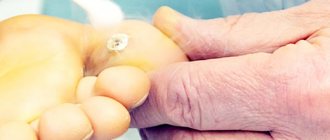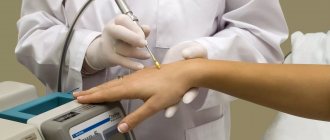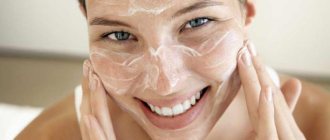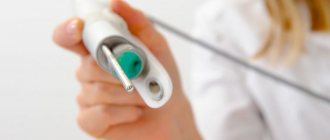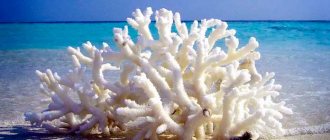Warts are small growths on the skin that usually do not cause pain. Some lesions are itchy and may hurt, especially if they appear on the legs. There are five types of warts: common warts (appear on the hands), flat warts (appear on the face and forehead), genital warts (condylomas, appear on the genitals, in the pubic area and between the thighs), plantar warts, subungual warts (located under or around fingernails and toenails).
How is cryodestruction of warts performed?
One of the quick methods for eliminating skin formations is cryodestruction - deep freezing or removing warts with liquid nitrogen. In the process of cauterization with liquid nitrogen and exposure to low temperatures (up to -196 degrees Celsius). As a result, the cells of the skin growth die, the papilloma dies, and the skin, after removing the wart, takes on its usual healthy appearance. Anesthesia is usually not required, and the procedure itself lasts no more than half a minute, which, of course, is a huge advantage among other methods for excision of moles.
The procedure is carried out manually by a dermatologist, with occasional anesthesia (if the removal of papillomas occurs in a small child or the size of the neoplasm itself is very large).
Thus, from a special reservoir in which liquid nitrogen is located, the required amount of this substance called “nitrogen” is drawn through an elongated applicator. Then, a cotton applicator is pressed against the growth and held on the affected area for up to 30 seconds. The larger the size of the papilloma, the longer the nitrogen applicator is held.
The burning time also depends on the location of the tumor: the plantar ones take the longest to remove, since the skin on the feet is quite rough. Additionally, we note that specialists with special medical education in ordinary cosmetology offices have the right to carry out the process, so going to a specialized clinic is not necessary.
Types of warts
Depending on the location and appearance, warts can be flat, vulgar and plantar.
Flat warts are often multiple, have the color of the surrounding skin and are small in size (no more than 5 mm), painless, with little or no surface roughness. The most common location of flat warts is the skin of the face.
Vulgar warts are larger (from 2 mm to 10 mm), located singly or in groups, protrude above the surface of the skin, have a pronounced rough surface, the color matches the color of the surrounding skin, sometimes they can have a yellowish, grayish or pink tint. In some cases, “black dots” are visible on the surface of a vulgar wart - this is the result of thrombosis of small capillaries feeding the neoplasm. Vulgar warts can be located in any part of the skin, but more often on the hands.
Plantar warts are localized on the skin of the soles, and due to pressure when walking, they grow inward, causing pain and discomfort. They can reach large sizes (up to 15–20 mm in diameter), the color is often yellowish. The characteristic differences between a plantar wart and a callus of the sole are a violation of the skin pattern of the sole and pain with lateral compression.
There is the ability for warts to resolve on their own as a result of the development of immunity to the human papillomavirus, but this is not so common. If warts last for a long time, they can spread through contact by rubbing the skin, as well as transmitting the virus to family members or organized groups.
The main way to treat warts is removal. Methods such as surgical, radio wave, laser, electrocoagulation, chemical destruction and cryodestruction are used.
What happens to a wart when it is exposed to liquid nitrogen?
What does papilloma look like after exposure to liquid nitrogen?
After the applicator with this freezing substance touches the skin growth, it begins to turn white, and its structure becomes denser. The wart may turn red after cauterization with nitrogen. Some time later, after completing the procedure under the unusual name “cryodestruction,” a blister containing serous fluid may form on the surface of the epithelium treated with nitrogen. The vesicle with transudate usually resolves within 7-10 days. The procedure does not leave any consequences on the surface of the epithelium, and there are no scars or marks left on it.
Patient reviews
Anna, 43 years old, Perm
She treated condylomas first with electrocoagulation - cauterization. During the procedure, there is a strong smell of burning and it is very painful. Then I removed them using cryodestruction of condylomas. Compared to cauterization, it’s heaven and earth. It didn't hurt, it was just cold and a little tingling. They haven't bothered me for 15 years now.
Elena, 35 years old, Moscow
More than once in my life I have had to struggle with condylomas. The last time I removed them was with liquid nitrogen surgery. This method is quite effective and painless. I completed 2 courses of cryotherapy and have been living peacefully for 6 years now, but I constantly support my immunity. I'm afraid that if immunity decreases, HPV and condylomas will make themselves felt again.
Is nitrogen cauterization painful?
The method of cauterizing a wart with liquid nitrogen is considered one of the most non-traumatic ways to eliminate skin lesions. Its cost, and the short recovery period after exposure to a freezing substance on the epidermis, make cryodestruction one of the popular methods of therapy.
As for the unpleasant, burning and prickly sensations, it all depends on the individual pain threshold of the person. In terms of sensitivity, the effect of liquid nitrogen on the epithelium causes a slight tingling sensation - similar to when you touch one of the metal objects in severe frost and hold your palm on it for a while.
Reviews from people who have been exposed to skin growths with a freezing substance also contain similar impressions of the procedure. As a rule, moles are small in size, and therefore no unpleasant feelings arise from cryodestruction. Even when a bubble appears after removing a wart with liquid nitrogen, it usually does not cause pain.
Benefits of removing warts with nitrogen
Advantages of cryodestruction of warts:
- does not require preliminary anesthesia;
- contraindications are minimal (cold allergy and cryoglobulinemia);
- there is no violation of the integrity of the skin or bleeding, which reduces the risk of secondary infection;
- no scars form after removal;
- The virus is destroyed by exposure to cold.
The main disadvantage of the method is that it does not get rid of tumors immediately, since the process of wart rejection occurs within 2–4 weeks. In some cases, repeated cryodestruction of elements is required.
Contraindications to the procedure
In order to cauterize the growth, you need to make sure that there are no contraindications for the procedure.
Exposure to warts with nitrogen is not carried out if:
- presence of high blood pressure;
- hyperemia and rashes near the affected area;
- elevated body temperature in a patient due to acute respiratory infections, flu, colds;
- infections;
- chronic inflammatory processes in the body;
- epilepsy;
- existing individual intolerance to the action of the ingredient on the skin (cold allergies).
Complications and consequences that arise or appear spontaneously after removing a wart with liquid nitrogen may still occur.
Causes of warts
Prerequisites for the formation of warts:
- neglect of personal hygiene rules (using someone else's shoes, washcloths, towels, manicure and pedicure instruments);
- increased skin moisture, especially hyperhidrosis of the feet and hands;
- immunodeficiency states of the body (HIV infection, cancer, treatment with cytostatics, viral hepatitis B and C);
- chronic stress;
- chronic dermatoses requiring treatment with external hormonal agents (atopic dermatitis, psoriasis, eczema and other itchy dermatoses);
- metabolic disorders in the body and hormonal dysfunctions.
Warts also often appear on thin baby skin.
Possible complications and consequences
Usually, after exposure to a wart, a bubble forms at the site where the skin was exposed to liquid nitrogen. It has a transudate inside and requires care - this factor should be taken into account. Until the blister resolves, the epithelium needs to be looked after: it must be treated with salicylic alcohol or use a weak solution of potassium permanganate. Under no circumstances should the bladder be punctured, otherwise complications may arise in the form of:
- inflammation in the epidermal area;
- increasing the regeneration period of the affected skin area;
- the appearance of a scar on the surface of the dermis.
We will consider further what needs to be done after cauterizing a wart with liquid nitrogen, because this is a very important question that interests many. The main thing is not to apply cosmetic tanning creams, dermis, or in general those that contain a chemical composition.
What drugs are used?
The prospect of getting rid of the neoplasm along with the root by freezing it is so attractive that it prompted developers in the field of pharmacology to create external agents that can cause a similar effect.
Freezing preparations are not as effective as cryodestruction; in particular, they are unlikely to get rid of large plantar warts, but small, recently formed growths can be removed using these means.
As an example, we should consider the effect of drugs such as Cryopharma and Wartner.
Cryopharma
The description for this product states that it has a freezing effect on the wart. The package contains a can of active ingredient, a plastic holder and applicators in the amount of 12 pieces. The device allows you to specifically apply the anti-wart product to their surface, excluding contact with healthy areas of the skin.
To use it, you need to insert the holder with the applicator into the hole of the can, and then attach the device to the surface of the growth. By pressing on the balloon, extract a portion of the substance and apply it to the wart. There is no need to press or rub it.
A single application is sufficient to remove one tumor. In two weeks it will fall off, revealing a layer of new, healthy skin underneath. Thus, the packaging is designed to remove 12 warts.
The advantages of this product indicated in the annotation include the following qualities:
- effectiveness with a single use;
- ease of use;
- possibility of treatment at home;
- Possibility of application for warts of various types;
- lack of time and material costs for complex manipulations in a medical facility;
- comfort for the patient after using the product.
The manufacturer claims that after using the drug Cryopharma, the patient can lead a normal lifestyle, not limit his needs for water procedures, even swimming is allowed.
As stated earlier, cryodestruction lacks such advantages. In addition, treatment at home is always preferable from the patients' point of view.
What to do after cauterization with liquid nitrogen
After burning with nitrogen has ended and a blister has appeared after exposure of the skin to nitrogen, it is necessary to provide post-procedure care for the area of the dermis where the wart was located.
What not to do:
- touch the bubble;
- puncture a blister;
- cut off the wart;
- wet the formation and the crust that appears on it;
- use cosmetics (if the papilloma was on the face);
- appear in the sun (if you do not want your dermis to turn black, especially if it is dark-skinned and has brought a number of other ailments).
A blister that appears on the epidermis is smeared with salicylic alcohol twice a day; eventually, a crust will appear on it, it will dry out, and there will be no marks or scars left on the surface. A new layer of healthy epithelium forms in place of the former wart. Typically, the complete healing process takes about 10 days. It is necessary to monitor the condition of the affected area daily, and if there is the slightest deterioration (if the blister begins to turn black or fester), you should consult a doctor.
To reduce the consequences of the procedure, and also to prevent the recurrence of warts, the patient must follow a number of measures.
Is pain relief necessary for cryodestruction of condylomas?
Anesthesia is not always used.
If you only need to remove one small condyloma with liquid nitrogen, anesthesia may not be used.
Because the technique is non-invasive and bloodless.
But if there are more than 2 anogenital warts, or if they are large in size, it is advisable to numb the skin.
They do this in two ways.
Anesthesia can be application or infiltration.
In the first case, cream is applied to the skin.
But it doesn’t work right away.
You need to wait up to 20 minutes before the effect is maximum.
Instant and better pain relief can be achieved by performing infiltration anesthesia.
Using a syringe with a thin needle, an anesthetic substance is injected into the skin.
It is injected at the base of the condyloma.
This area completely loses sensitivity because the passage of impulses along the nerve endings is blocked.
Nitrogen burning technology
The liquid nitrogen treatment method does not require special preparation from the patient for the procedure. After examining the neoplasm, the doctor will numb the affected area for extensive lesions of the skin; for isolated rashes, the procedure can be performed without analgesics. With the help of cryotherapy, viral skin formations, other skin defects, and core calluses are successfully removed. Nitrogen acts instantly. Local or injectable medications are used as painkillers.
The technology for performing cryodestruction allows the use of a special directed nitrogen-spraying device, medical forceps or scissors, and a cotton swab with a long stem.
A special installation for spraying the drug is used in modern private clinics, and a cotton swab is used in government institutions. It cannot be said that the method of treatment with a spray installation is superior to the second method; the depth of impact is the same, but special equipment makes the procedure much more expensive.
The essence of the method of burning out the spine with liquid nitrogen is to expose the growth to ultra-low temperatures. To do this, the substance is converted into a solid state and stored in special thermal containers.
Before removing the growth, the area of skin around it is treated with antiseptic solutions and the procedure begins. The specialist immerses a cotton swab in a container with nitrogen and applies it with light pressure on the spine. If the procedure is performed with a spray installation, then a special applicator is applied to the lesion site, through which the substance is supplied, or nitrogen is remotely sprayed onto the papilloma through a nozzle, avoiding cold contact with healthy skin.
The substance comes into contact with the skin for 25-30 seconds, after which the doctor takes a break to assess the condition of the growth. After 30-60 seconds, the exposure of the spine to nitrogen is resumed if necessary. The procedure requires from 3 to 7 applications, the roots and cells mutated from the effects of the virus go deep into the skin. To remove papilloma permanently, it is necessary to destroy all cells and vessels feeding the defect with cold.
In places where there is increased friction of the papilloma on shoes or clothing, if the wart is old and extensive, an additional visit to the doctor will be required to remove it no earlier than a month after the wound has healed.
Regrowth after removal of condylomas
Sometimes new ones appear in place of condylomas removed with liquid nitrogen.
The reason for their formation is incomplete removal of the wart.
Perhaps the doctor undertook to remove too large a condyloma with nitrogen.
It would be better to remove it with a radio wave.
But the clinic does not have the appropriate equipment.
Therefore, the doctor removes it as best he can.
But he is afraid to freeze tissue at great depths to avoid complications.
Such situations do not arise in our clinic.
If the condyloma is large, we will not use liquid nitrogen to remove it.
Because we have all the technical capabilities to use other methods.
Including laser, electrocoagulation, radio wave removal of anogenital warts.
We use not only local treatment of papillomavirus infection.
Condylomas appear due to decreased immunity.
To prevent them from forming again on the skin at the site of removal or nearby, systemic treatment is also necessary.
It is aimed at suppressing viral activity and strengthening the immune system.
Antiviral treatment of condylomas
Before starting treatment, the patient undergoes an immunogram.
An immunologist looks at what immune disorders are present.
They are almost always detected if a person has many condylomas or they are large.
After this, immune drugs are prescribed.
Interferons are used.
They have antiviral, antiproliferative, immunostimulating effects.
PCR studies show a decrease in viral load with the use of interferons.
They are used both locally and systemically.
When used systemically, side effects are possible.
This is an increase in body temperature, myalgia, headache.
Side effects can be treated with non-steroidal anti-inflammatory drugs.
Other drugs that may be used:
- imiquimod;
- inducers of endogenous interferon (isoprinosine, Gepon);
- drugs that stimulate T-cell immunity;
- immunostimulants and antiviral agents with an unknown mechanism of action, including herbal origin.
The doctor selects the treatment regimen individually.
Therapy continues for several months.
Advantages of cryodestruction of condylomas
There are many methods for removing condylomas.
Different techniques are used in different situations.
Because they all have their advantages and disadvantages.
Let's start by describing the benefits of liquid nitrogen.
- Availability.
No special devices are needed, as for laser vaporization or radio wave removal.
No special skills are required.
Any doctor can quickly master the cryodestruction technique.
Therefore, it can be performed in almost any dermatovenerological office.
After all, to remove it, just apply a cotton swab with liquid nitrogen to the condyloma and hold it for a few seconds.
- Possibility of carrying out without anesthesia.
The anesthesia itself is often frightening for patients.
After all, to do this you need to inject an anesthetic under the skin using a needle.
Some people are allergic to drugs.
Some people are simply afraid of injections.
For them, it is preferable to remove condylomas with liquid nitrogen.
After all, this procedure is the least painful of all.
True, pain may occur after the procedure, when the tissue begins to thaw.
- Versatility.
Condylomas can be removed anywhere.
Gynecologists also remove them on the cervix with liquid nitrogen.
Other techniques have certain limitations.
- Price
Removing condylomas with liquid nitrogen is quite inexpensive.
There are many patients who prefer not to use new medical technologies.
They want to undergo treatment using the good old, but inexpensive method.
For them, cryodestruction is perfect.
The procedure itself costs less.
In addition, no anesthetic injection is required.
But these are additional financial costs.
- Bloodlessness.
Removing condylomas with liquid nitrogen is a non-invasive procedure.
That is, during its implementation, the instrument does not penetrate the skin and does not disturb the internal environment of the body.
There is no bleeding or risk of infection.
Although in some cases infection occurs later if the patient does not properly care for the wound.
